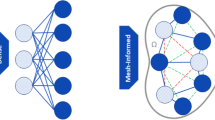Abstract
Recently, solving partial differential equations (PDEs) using neural networks (NNs) has been attracting increasing interests with promising potential to be applied in wide areas. In this paper, we propose a theoretical model that approximates the operator from a parametric function space to a solution function space and prove its universal approximation theorem in the operator space. For practical application, by regarding the domain of a parametric (or solution) function as a discrete point cloud, we propose a novel idea that implements the theoretical model by introducing the point-based NN as the backbone. We show that the present model can approximate the solution operator of static PDEs using the training data generated on unstructured meshes while most existing methods work for the data generated on lattice grid meshes. We conduct experiments to demonstrate the performance of our model on different types of PDEs. The numerical results verify that our model possesses a higher precision and a faster inference speed compared with the existing models for data of unstructured meshes; in addition, our model has competitive performance compared with the existing works dealing with data of lattice grid meshes.
Access this chapter
Tax calculation will be finalised at checkout
Purchases are for personal use only
Similar content being viewed by others
References
Lagaris, I.E., Likas, A., Fotiadis, D.I.: Artificial neural networks for solving ordinary and partial differential equations. IEEE Trans. Neural Networks 9(5), 987–1000 (1998)
He, J., Xu, J.: Mgnet: a unified framework of multigrid and convolutional neural network. Sci. China Math. 62(7), 1331–1354 (2019)
Kochkov, D., Smith, J.A., Alieva, A., Wang, Q., Brenner, M.P., Hoyer, S.: Machine learning-accelerated computational fluid dynamics. Proc. Natl. Acad. Sci. 118(21), e2101784118 (2021)
Ramuhalli, P., Udpa, L., Udpa, S.S.: Finite-element neural networks for solving differential equations. IEEE Trans. Neural Networks 16(6), 1381–1392 (2005)
Ling, J., Kurzawski, A., Templeton, J.: Reynolds averaged turbulence modelling using deep neural networks with embedded invariance. J. Fluid Mech. 807, 155–166 (2016)
Beck, A., Flad, D., Munz, C.D.: Deep neural networks for data-driven les closure models. J. Comput. Phys. 398, 108910 (2019)
Raissi, M., Perdikaris, P., Karniadakis, G.E.: Physics-informed neural networks: a deep learning framework for solving forward and inverse problems involving nonlinear partial differential equations. J. Comput. Phys. 378, 686–707 (2019)
Weinan, E., Yu, B.: The deep Ritz method: a deep learning-based numerical algorithm for solving variational problems. Commun. Math. Stat. 6(1), 1–12 (2018)
Anandkumar, A., et al.: Neural operator: graph kernel network for partial differential equations. In: ICLR 2020 Workshop on Integration of Deep Neural Models and Differential Equations (2020)
Li, Z., Kovachki, N., Azizzadenesheli, K., Liu, B., Stuart, A., Bhattacharya, K., Anandkumar, A.: Multipole graph neural operator for parametric partial differential equations. In: Advances in Neural Information Processing Systems, vol. 33 (2020)
Li, Z., et al.: Fourier neural operator for parametric partial differential equations. In: International Conference on Learning Representations (2020)
Bhattacharya, K., Hosseini, B., Kovachki, N.B., Stuart, A.M.: Model reduction and neural networks for parametric PDEs. The SMAI J. Comput. Math. 7, 121–157 (2021)
Qi, C.R., Su, H., Mo, K., Guibas, L.J.: Pointnet: Deep learning on point sets for 3d classification and segmentation. In: Proceedings of the IEEE Conference on Computer Vision and Pattern Recognition, pp. 652–660 (2017)
Qi, C.R., Yi, L., Su, H., Guibas, L.J.: Pointnet++: deep hierarchical feature learning on point sets in a metric space. In: Advances in Neural Information Processing Systems, vol. 30 (2017)
Thomas, H., Qi, C.R., Deschaud, J.E., Marcotegui, B., Goulette, F., Guibas, L.J.: Kpconv: flexible and deformable convolution for point clouds. In: Proceedings of the IEEE/CVF International Conference on Computer Vision, pp. 6411–6420 (2019)
Wu, W., Qi, Z., Fuxin, L.: Pointconv: deep convolutional networks on 3D point clouds. In: Proceedings of the IEEE/CVF Conference on Computer Vision and Pattern Recognition, pp. 9621–9630 (2019)
Hornik, K., Stinchcombe, M., White, H.: Multilayer feedforward networks are universal approximators. Neural Netw. 2(5), 359–366 (1989)
Leshno, M., Lin, V.Y., Pinkus, A., Schocken, S.: Multilayer feedforward networks with a nonpolynomial activation function can approximate any function. Neural Netw. 6(6), 861–867 (1993)
Chen, T., Chen, H.: Universal approximation to nonlinear operators by neural networks with arbitrary activation functions and its application to dynamical systems. IEEE Trans. Neural Networks 6(4), 911–917 (1995)
Dugundji, J.: An extension of Tietze’s theorem. Pac. J. Math. 1(3), 353–367 (1951)
Ronneberger, O., Fischer, P., Brox, T.: U-Net: convolutional networks for biomedical image segmentation. In: Navab, N., Hornegger, J., Wells, W.M., Frangi, A.F. (eds.) MICCAI 2015. LNCS, vol. 9351, pp. 234–241. Springer, Cham (2015). https://doi.org/10.1007/978-3-319-24574-4_28
Hendrycks, D., Gimpel, K.: Gaussian error linear units (gelus). arXiv preprint arXiv:1606.08415 (2016)
Acknowledgments
This work is jointly supported by the National Key R &D Program of China (No. 2018AAA0100303), the Shanghai Municipal Science and Technology Major Project (No.2018SHZDZX01) and the ZHANGJIANG LAB, the National Natural Science Foundation of China under Grant 62072111.
Author information
Authors and Affiliations
Corresponding author
Editor information
Editors and Affiliations
Rights and permissions
Copyright information
© 2023 The Author(s), under exclusive license to Springer Nature Switzerland AG
About this paper
Cite this paper
Hua, N., Lu, W. (2023). Solving Partial Differential Equations Using Point-Based Neural Networks. In: Tanveer, M., Agarwal, S., Ozawa, S., Ekbal, A., Jatowt, A. (eds) Neural Information Processing. ICONIP 2022. Lecture Notes in Computer Science, vol 13623. Springer, Cham. https://doi.org/10.1007/978-3-031-30105-6_1
Download citation
DOI: https://doi.org/10.1007/978-3-031-30105-6_1
Published:
Publisher Name: Springer, Cham
Print ISBN: 978-3-031-30104-9
Online ISBN: 978-3-031-30105-6
eBook Packages: Computer ScienceComputer Science (R0)




